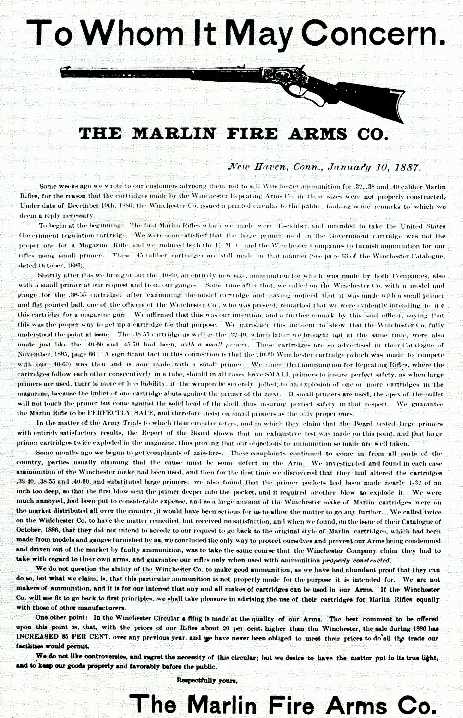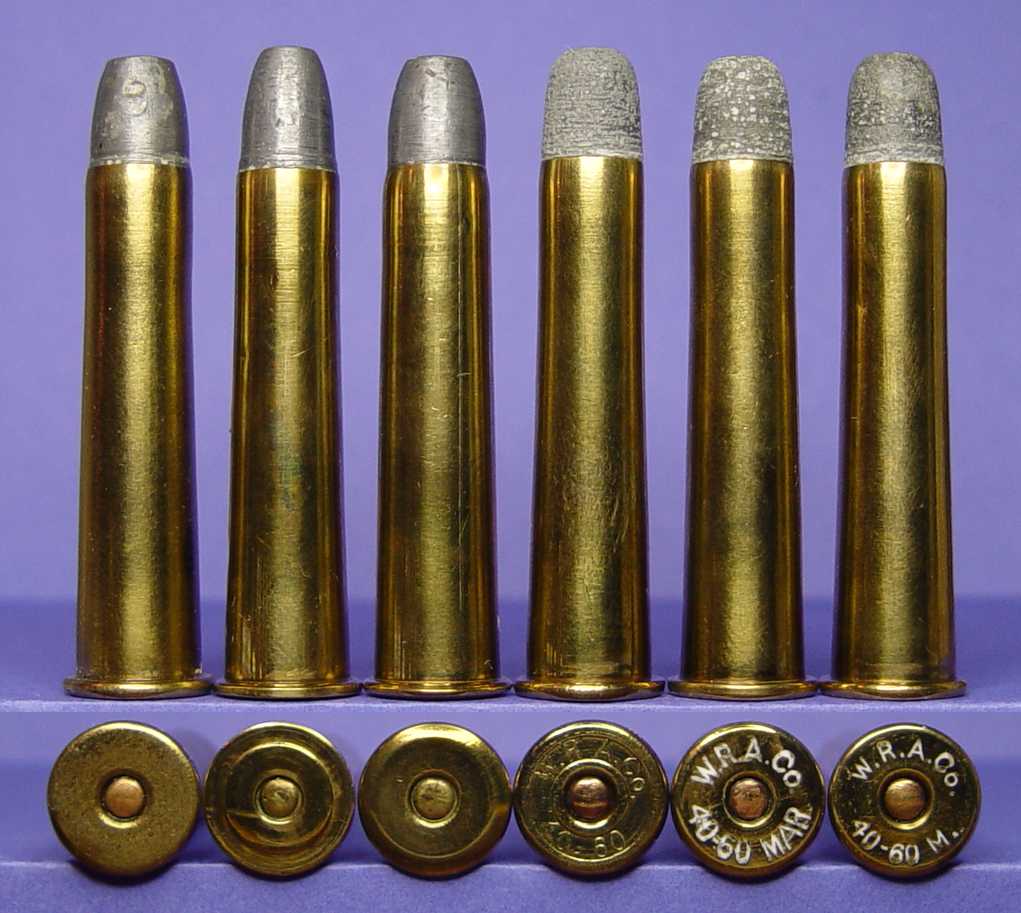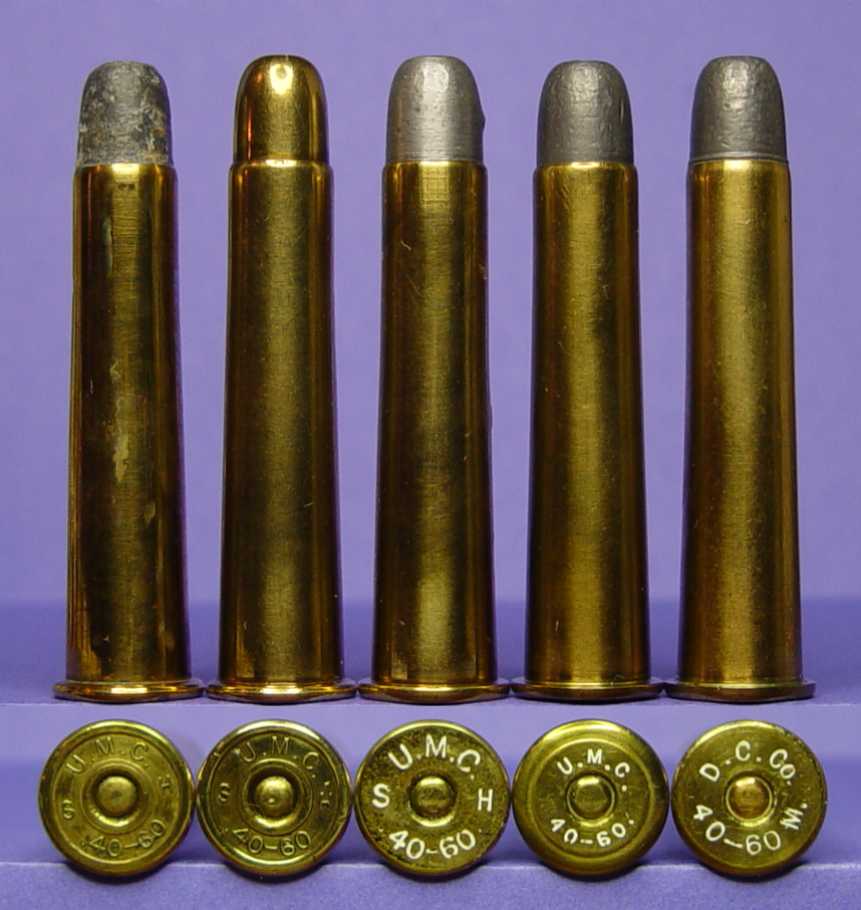|
THE CARTRIDGE COLLECTOR'S EXCHANGE |
| Contents
Cartridge
Lists
Prior Picture Pages:
for April thru June 2011
*September
2012
Cartridge Collectors Organizations:
Auctions:
Books:
Other Collector's Sites:
|
Home of the Old Ammo Guy's Virtual
Cartridge Trading Table
Picture Page July 2013 The Marlin family of old lever action rifle cartridges..... It is an interesting concept, given the fact that the Marlin Firearms
Company was in direct competition with the Winchester Repeating Arms Company
in the lever action repeating rifle market, that they would arrange for
Winchester to produce the ammunition for their rifles. As they had no
ammunition production facilities themselves, and Winchester and other
members of the monopolistic Ammunition Manufacturers Association had tight
control over the supplies of ammunition-making components from about 1883
until 1907, Marlin had to deal with someone, so why not make it one of the
industry leaders. This relationship between the two competitors began
shortly after Marlin began production of it's first lever-action repeating
rifle, the Model 1881 which was introduced in .45-70 with a .40-60 soon
added, as Winchester included the
.40-60 Marlin cartridge in its 1882 catalog. Most of the cartridges that
were manufactured by Winchester specifically for Marlin had 'Marlin', 'Mar'
The relationship between Marlin
and Winchester was not always a smooth one. One thing that Marlin insisted
on was that their cartridges be fitted with small primers for the purpose of
reducing the possibility of the cartridges in a tubular magazine being
detonated if the rifle was subjected to a heavy jolt. In January of 1887,
"To Whom It May Concern.
THE MARLIN FIREARMS CO.
New Haven, Conn., January 10, 1887.
Some weeks ago we wrote to our customers advising them not to sell Winchester ammunition for .32, ,38 and .40 caliber Marlin Rifles, for the reason that the cartridges made by the Winchester Repeating Arms Co. in these sizes were not properly constructed. Under date of December 10th, 1896, the Winchester Co. issued a printed circular to the public , making some remarks to which we deem a reply is necessary. To begin at the beginning: The first Marlin Rifles which we made were .45-caliber, and intended to take the United States Government regulation cartridge. We were soon satisfied that the large primer used in the Government cartridge was not the proper one for a Magazine Rifle, and we induced both the U.M.C. and the Winchester Companies to furnish ammunition for our rifles using small primers. These .45-caliber cartridges are still made in that manner (see page 63 of the Winchester Catalogue, dated October, 1896). Shortly after this we brought out the .40-60, an entirely new size, ammunition for which was made by both Companies, also with a small primer at our request and from our gauges. Some time after that, we called on the Winchester Co. with a model and gauge for the .38-55 cartridge; after examining the model cartridge and having noticed that it was made with a small primer and flat pointed ball, one of the officers of the Winchester Co., who was present, remarked that we were evidently intending to use this cartridge in a magazine gun. We affirmed that this was our intention, and a further remark by this said officer, saying that this was the proper way to get up a cartridge for that purpose. We introduce this incident to show that the Winchester Co. fully understood the point at issue. The .38-55 cartridge as well as the .32-40, which latter we brought out at the same time, were also made just like the .40-60 and .45-70 had been, with a small primer. These cartridges are so advertised in their Catalogue of November, 1885, page 66. A significant fact in this connection is that the .40-60 Winchester cartridge (which was made to compete with our .40-60) was then and is now made with a small primer. We claim that ammunition for Repeating Rifles, where the cartridges follow each other consecutively in a tube, should in all cases have SMALL primers to ensure perfect safety, as when large primers are used, there is more or less liability, if the weapon be severely jolted, to an explosion of one or more cartridges in the magazine, because the bullet of one cartridge abuts against the primer of the next. If small primers are used, the apex of the bullet will not touch the primer but come against the solid head of the shell, thus insuring perfect safety in that respect. We guarantee the Marlin Rifle to be PERFECTLY SAFE, and therefore insist on small primers as the only proper ones. In the matter of the Army Trials to which their circular refers, and in which they claim that the Board tested large primers with entirely satisfactory results, the Report of the Board shows that an exhaustive rest was made on this point, and that the large primer cartridges twice exploded in the magazine, thus proving that our objections to ammunition so made are well taken. Some months ago we began to get complaints of missfires. These complaints continued to come in from all parts of the country, parties usually claiming that the cause must be some defect in the Arm. We investigates and found that in each case ammunition of the Winchester make had been used, and then for the first time we discovered that they had altered the cartridges .32-40, .38-55 and .40-60, and substituted large primers; we also found that the primer pockets had been made nearly 1-32 on an inch too deep, so that the first blow sent the primer deeper into the pocket, and it required another blow to explode it. We were much annoyed, had been put to considerable expense, and as a large amount of the Winchester make of Marlin cartridges were on the market distributed all over the country, it would have been serious for us to allow the matter to go any further. We called twice on the Winchester Co. to have the matter remedied, but received no satisfaction, and when we found, in the issue of their catalogue of October, 1886, that they did not intend to accede to our request to go back to the original style of Marlin cartridges, which had been made from models and gauges furnished by us, we concluded the only way to protect ourselves and prevent our Arms being condemned and driven out of the market by faulty ammunition, was to take the same course that the Winchester Company claim they had to take with regard to their own arms, and guarantee our rifles only when used with ammunition properly constructed. We do not question the ability of the Winchester Co. to make good ammunition, as we have had abundant proof that they can do so, but what we claim, is, that this particular ammunition is not properly made for the purpose it was intended for. We are not makers of ammunition, and it is for our interest that any and all makes of cartridges can be used in our Arms. If the Winchester Co. will see to go back to first principles, we shall take pleasure in advising the use of their cartridges for Marlin Rifles equally with those of other manufacturers. One other point: In the Winchester circular, a fling is made at the quality of our Arms. The best comment to be offered upon this point is, that, with the prices of our Rifles about 20 per cent. higher than the Winchester, the sale during 1886 has INCREASED 85 PER CENT. over any previous year, and we have never been obliged to meet their prices to do all the trade our facilities would permit. We do not like controversies, and regret the necessity of this circular; but we desire to have the matter put in its true light, and to keep our goods properly and favorably before the public. Respectfully yours, The Marlin Firearms Co." The next two pictures show eleven .40-60 Marlin (or for those not identified in the headstamp as Marlin, possibly .40-60 Colt, which also used the small primer) variations. Those in the first picture were made by (from the left) Winchester, UMC, Remington, and three more by Winchester with headstamps, the first of these three having a raised headstamp.
. . . . . . . . . . . . .
The second picture shows two with raised headstamps by UMC, the second of which is a hollow bullet dummy, followed by two also made by by UMC with impressed headstamps, and one by the Dominion Cartridge Co
. . . . . . . . . . . . . . . . .
|

 after
receiving complaints of misfires with its rifles and determining that it was
the ammunition that was at fault, the company launched an advertising
campaign accusing Winchester of producing sub-standard ammunition which
tended to miss-fire in Marlin rifles. The ad shown here in the form of an
open letter written 'to whom it may concern' is dated January 10, 1887, and
was reproduced in the April 1992 Gun Report Magazine, having been found by a
reader in a Field and Stream Magazine, the publication date of which was not
provided. The problem apparently involved primer pockets which were deeper
than Marlin specifications called for in it's .32, .38 and .40 caliber
cartridges, resulting in the primers being seated too far into the heads of
the cases to allow for dependable ignition. The cartridges in question were
the .32-40, .38-55, and .40-60. I don't know what long term effects this
controversy had on the relationship between the two companies, but I suspect
that it gave reason for Marlin to direct more attention to the other
ammunition makers such as the Union Metallic Cartridge Company and the
United States Cartridge Company in its future contracts. While USC Co was
not a manufacturer of Marlin cartridges at the time the letter was written,
their 1891 catalog has a listing for the .40-60 Marlin. As the print is
difficult to read, I have reproduced the Marlin letter below:
after
receiving complaints of misfires with its rifles and determining that it was
the ammunition that was at fault, the company launched an advertising
campaign accusing Winchester of producing sub-standard ammunition which
tended to miss-fire in Marlin rifles. The ad shown here in the form of an
open letter written 'to whom it may concern' is dated January 10, 1887, and
was reproduced in the April 1992 Gun Report Magazine, having been found by a
reader in a Field and Stream Magazine, the publication date of which was not
provided. The problem apparently involved primer pockets which were deeper
than Marlin specifications called for in it's .32, .38 and .40 caliber
cartridges, resulting in the primers being seated too far into the heads of
the cases to allow for dependable ignition. The cartridges in question were
the .32-40, .38-55, and .40-60. I don't know what long term effects this
controversy had on the relationship between the two companies, but I suspect
that it gave reason for Marlin to direct more attention to the other
ammunition makers such as the Union Metallic Cartridge Company and the
United States Cartridge Company in its future contracts. While USC Co was
not a manufacturer of Marlin cartridges at the time the letter was written,
their 1891 catalog has a listing for the .40-60 Marlin. As the print is
difficult to read, I have reproduced the Marlin letter below:
